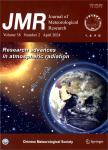Variations of Winter Precipitation over Southeastern China in Association with the North Atlantic Oscillation
Variations of Winter Precipitation over Southeastern China in Association with the North Atlantic Oscillation作者机构:Zhejiang Provincial Meteorological Observatory Zhejiang Institute of Meteorological Sciences Zhejiang Meteorological Service Center
出 版 物:《Journal of Meteorological Research》 (气象学报(英文版))
年 卷 期:2017年第31卷第3期
页 面:476-489页
核心收录:
学科分类:07[理学] 0707[理学-海洋科学] 070601[理学-气象学] 0815[工学-水利工程] 0706[理学-大气科学] 0816[工学-测绘科学与技术] 0824[工学-船舶与海洋工程] 0825[工学-航空宇航科学与技术]
基 金:Supported by the National Natural Science Foundation of China(41405047 and 41675086) China Meteorological Administration Special Public Welfare Research Fund(GYHY201306010)
主 题:precipitation regime North Atlantic Oscillation (NA0) cluster analysis westerly jet stream
摘 要:The synoptic-scale winter precipitation variations over southeastem China (22°-32°N, 105°-125°E) and their asso- ciation with the North Atlantic Oscillation (NAO) during 1951-2007 are investigated in this paper. The variability of wintertime precipitation is characterized by meridional displacement of its maximum center. Two precipitation re- gimes, with maximum centers located over the Yangtze and Pearl River basins, are identified via cluster analysis. Time-lagged analyses suggest that the two precipitation regimes are connected with the decaying phases of positive NAO (NAO+) events of different amplitudes. A strong (medium) NAO+ event is defined as one when the maximum amplitude of the NAO index exceeds 1.0 (in the range of 0.7-1.0) for at least 4 consecutive days and drops to less than 0.3 within 7 days following the peak index. After the peak of a strong NAO+, southerly winds expand north- ward to the Yangtze River (about 30°N), a northeast-southwest-tilted trough migrates to east of Lake Baikal, and cold air intrudes into central eastern China; thus, precipitation is strengthened over the Yangtze River basin where warm and cold air masses converge. In comparison, during the decaying phase of medium NAO+ events, the south- erly winds are relatively weak, and precipitation tends to be enhanced at lower latitudes (around 25°N). Further ana- lysis indicates that downstream Rossby-wave propagation may account for the latitudinal expansion of the southerly wind anomalies over the eastern coastal area of China during the decaying phase of NAO+ events of different strengths.



